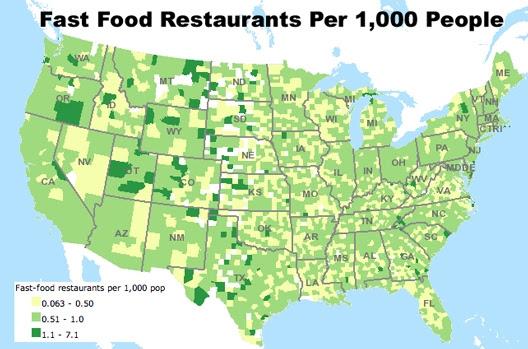It’s hard to deny that we’ve become more impatient as a society. Surely, technological innovations are a big part of the story—while we used to wait for weeks or months for letters to arrive, email arrives instantly. Research that used to entail sifting through piles of journals is now accomplished with just a few clicks of a mouse. This societal shift towards instantaneity is manifest in our very sustenance. Frozen prepared meals save us from having to spend time preparing food and the microwave saves us from having to wait for an oven to cook it. Better yet, fast-food restaurants offer hot meals that can be picked up at drive-thru windows and are ready to be consumed on the go.
From its production to its consumption, fast food both embodies and symbolizes speed and instant gratification (1). Through extensive franchising and large advertising budgets, fast-food organizations shape many of the cues in our everyday ecological environment. While the proliferation of fast food is undoubtedly driven by the market’s response to our demand for speed and instant gratification, the prevalence of fast food in our daily life may play a role in egging on our impatience. This is a potentially ironic consequence, as the capacity of fast food to save us time would appear to be an unambiguous good. However, if the speed and instant gratification associated with fast food pushes us to be even more impatient, then it may undermine well-being in domains where the pleasure of the activities lie in savoring them or when well-being entails undertaking tasks that require the delay of gratification.
In a series of papers (2), my collaborators Julian House, Chen-Bo Zhong, and I have begun to examine some potential manifestations of impatience that exposure to fast food might incite. Our initial approach to this was to experimentally prompt participants with reminders of fast food, such as viewing pictures of fast-food logos or having them recall recent fast-food restaurant experiences. Across, a variety of different studies we observed that fast food spurred participants to hurry through reading a paragraph describing their city, express a greater desire for time-saving products, exhibit a diminished ability to savor (happiness derived from gazing at pictures of natural beauty or the ability to enjoy listening to a beautiful opera duet), and save for tomorrow (preferring an immediate financial reward over a larger, delayed one). Our interpretation of these results is that the activation of goals associated with fast food elicited the impatient behaviors.
These experimental findings are interesting in their own right, but that our associations with fast food can induce greater impatience is especially important to consider because of their pervasiveness in our modern-day environment and often our exposure to them arrives unbidden as we go about our everyday life. So these experimental findings prodded us to consider whether the prevalence of fast-food restaurants in our neighborhoods might undercut our well-being. There’s a long tradition in the epidemiology literature attesting to a link between the prevalence of fast-food restaurants in our neighborhoods and obesity, even when controlling for individual and economic factors (3). While the consequences of fast food for our health seem quite obvious, we wondered what these same methods might reveal regarding impatience. We took a page from the epidemiology method book to see whether the prevalence of fast-food restaurants in our neighborhood would be associated with diminished tendencies to savor and save.
In one study, we simply administered the Emotion Regulation Profile-Revised (4) that measures the emotional response to enjoyable experiences generally to a set of respondents on MTurk. This is a vignette-based scale of savoring tendencies that measures individuals’ typical emotional responses to a variety of realistic, enjoyable experiences (e.g., winning a prize in a lottery, finally finishing a dull but important task you’ve been putting off, vacationing with your partner, discovering a beautiful waterfall on a hike). These scenarios cover a wide range of social and solitary pleasures and participants are asked to indicate which responses described in a list are typical of how they would react in such a situation. This instrument allows us to assess how exposure to fast food impacts savoring behavior generally.

Based on their zip code, we linked participants’ responses to objective information from the most recent US Economic Census on the ratio of fast-food restaurants to sit-down restaurants (5). Prior work (6) has shown that income is negatively related to savoring tendencies and we replicated these findings of income (both an individual’s income as well as the median income of the zip code had a significant negative association with savoring) and showed that the prevalence of fast-food restaurants had a negative effect on savoring controlling for both of these economic factors. Thus, there is some external validity to our laboratory findings for the deleterious effect of fast food on savoring can be generalized across a wide variety of pleasant experiences in people’s everyday lives. We’ve long thought that the prevalence of fast food in our local environment could have a detrimental influence on our health, but this provides some very suggestive evidence that the presence of fast food in our daily life may also be affecting us in a negative psychological way.
In order to see whether there was converging evidence for the prevalence of fast food on financial impatience, we obtained the geocode data from respondents in a large nationally representative data set maintained by the Bureau of Labor Statistics that included the following measure of people’s financial impatience in 2006 so that we could use the same measure of fast-food restaurant prevalence as in the savoring survey. The question we looked at was:
“Suppose you have won a prize of $1000, which you can claim immediately. However, you can choose to wait one month to claim the prize. If you do wait, you will receive more than $1000. What is the smallest amount of money in addition to the $1000 you would have to receive one month from now to convince you to wait rather than claim the prize now?”
We used the amount respondents’ specified to calculate their monthly discount factor by dividing 1000 by 1000 plus the additional amount specified to wait 1 month to receive the prize. Thus, a delay discount factor of 1 reflects total patience and values lower than 1 reflect successively greater impatience. What we observed was that the higher the concentration of fast-food restaurants in respondents’ neighborhoods, the less financially patient they were (i.e., they demanded a larger amount of $ required to delay getting that $1000 by one month). The correlation is small (r = -.08, similar in size to the correlation of r = -.14 we observed with a tendency to savor), but robust when we control for a whole host of other variables both at the neighborhood level (median household income and population) and individual level (ethnicity, education, income, and net worth).
This corroborating evidence was reassuring, but these relationships could simply be driven by impatient people choosing to live in neighborhoods that have more fast-food restaurants. To address this concern, we turned to nationally representative panel data where we could follow US households over a decade-long period and see whether changes in the prevalence of fast food were associated with changes in their savings. Indeed, we find a robust relationship within households over time between the prevalence of fast-food restaurants in their neighborhood and lower savings (using fixed effects to control for all the stable things associated with that household such as their ethnic background, and underlying static individual characteristics as well as economic factors). Now it’s always tricky to draw causal conclusions from such survey data, even when it’s longitudinal as there are always potential unmeasured third variables lurking—so caution is warranted. But when you look at these results in the context of the experimental data, it suggests that one important step you can take to nudge (7) yourself towards being more patient would be to live in a neighborhood that doesn’t constantly bombard you with reminders of instant gratification.
While there’s no doubt that we’ve become more impatient as a society and that there are many factors that have contributed to it, thinking more explicitly about the subtle cues in our everyday living environment may be a fruitful way for us to combat the impulse for speed and instant gratification that can impede our propensity to smell the preverbal roses or erode our ability to make choices that have our long term economic interests in mind. From a policy perspective, we should seek to expand our net of concern about the potential negative influence of fast food to be broader than just physical health to include our emotional and financial well-being. From a personal perspective, you might do your body, mind, and pocketbook a favor when you plan your next move by checking to see that the number of sit-down restaurants outnumbers the number of fast-food restaurants. It’s at least food for thought!
Sanford E. DeVoe is an Associate Professor at Rotman School of Management at University of Toronto. He studies the role organizations play in influencing how we look at the tradeoffs between time and money and how each is valued. You can contact him at [email protected] and read more of his work here: http://www.rotman.utoronto.ca/FacultyAndResearch/Faculty/FacultyBios/DeVoe.aspx
Footnotes
1.Ritzer, G. (1993). The McDonaldization of society. Newbury Park, CA: Pine Forge Press.
Schlosser, E. (2001). Fast Food Nation: The Dark Side of the All-American Meal. New York: Harper Perennial.
2. DeVoe, S. E., House, J., & Zhong, C-B. (2013). Fast food and financial impatience: A socio-ecological approach. Journal of Personality and Social Psychology, 105, 476-494.
House, J., DeVoe, S. E., & Zhong, C-B. (in press). No time to smell the roses: Exposure to fast food impedes happiness. Social Psychological and Personality Science. First published on November 14, 2013 as doi:10.1177/1948550613511498.
Zhong, C-B., & DeVoe, S. E. (2010). You are how you eat: Fast food and impatience. Psychological Science,21, 619-622.
3. Mehta, N. K., & Chang, V. W. (2008). Weight status and restaurant availability: A multilevel analysis.American Journal of Preventative Medicine, 34, 127-133.
4. Nelis, D., Quoidbach, J., Hansenne, M., & Mikolajczak, M. (2011).Measuring individual differences in emotion regulation: The Emotion Regulation Profile-Revised (ERP-R). Psychologica Belgica, 51, 49–91.
5. Consistent with the prior obesity research on the prevalence of fast food by Mehta and Change (2008), we used the North American Industry Classification System (NAICS) for the ratio of the number of fast-food restaurants (NAICS code 722211) to full-service restaurants (NAICS code 722110) in each zip code. This ratio measure adjusts for the relative presence of other restaurants in a neighborhood, which is likely to be a good proxy for characteristics of a neighborhood that may be correlated with the presence of fast-food restaurants and with factors that may contribute to saving, such as urbanicity. See DeVoe et al. (2013) for a further discussion of this and how analyzing the raw number of fast-food restaurants and sit-down restaurants as separate predictors does not substantively change the results.
6. Quoidbach, J., Dunn, E. W., Petrides, K. V., & Mikolajczak, M. (2010). Money giveth, money taketh away: The dual effect of wealth on happiness. Psychological Science, 21, 759–763.
7.Thaler, R. H. & Sunstein, C. R. (2008). Nudge: Improving decisions about health, wealth and happiness. New Haven, CT: Yale University Press.




